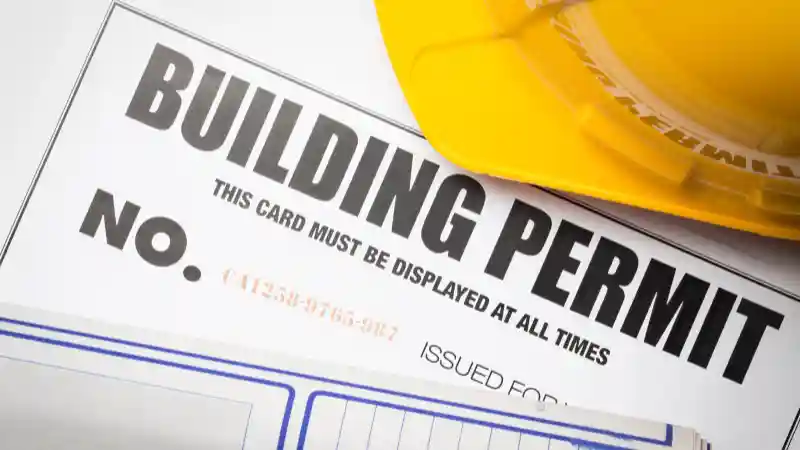Chain link fences are a popular choice for homeowners and businesses looking for an affordable and durable fencing option. However, note that before beginning the installation process, it’s important to ensure that all necessary building permits and permissions have been obtained.
Permit requirements for chain link fence installation can vary depending on the location and purpose of the fence, as well as local zoning regulations and building codes. In this article, we will discuss some common permit requirements for chain link fence installation and offer tips for navigating the permit process.

Property Boundary and or Pin Survey
A property boundary survey is a survey conducted by a licensed surveyor to identify the exact boundaries of a property. The purpose of this survey is to ensure that the fence is being installed within the property lines and not on adjacent properties. If the fence is installed outside of the approved property boundaries, it may encroach on a neighboring property or violate local zoning laws. As a result, making it one of the key permit requirements for chain link fence installation in many cities.
In many other cities and localities, property boundary surveys are one of the vital permit requirements for chain link fence installation. This is because local authorities want to ensure that the fence is being installed in compliance with local regulations and that the property owner is not infringing on the rights of neighboring property owners.
In addition to ensuring compliance with local laws, a property boundary survey can also help to avoid disputes with neighbors over property lines. By having a clear understanding of the exact boundaries of their property, property owners can avoid accidentally encroaching on their neighbors’ property or vice versa.
Overall, obtaining a property boundary survey is an important step in the chain link fence installation process, as it helps to ensure compliance with local laws and avoid disputes with neighbors.
Height Restrictions
Height restrictions are a common permit requirements for chain link fence installation because they play a crucial role in maintaining the aesthetic appeal of a neighborhood, preserving property values, and ensuring public safety. Height restrictions on fences and gates are typically set by local governments and can vary depending on the location and zoning regulations of the area.
One of the main reasons for height restrictions on chain link fences is to maintain the visual appeal of a neighborhood. A fence that is too tall can be an eyesore and detract from the overall appearance of the residential community. In addition, excessively tall fences can create privacy concerns for neighbors and create a sense of division within the community.
Height restrictions on chain link fences also play an important role in preserving property values. A fence that is too tall can obstruct views and create a sense of isolation, which can negatively impact property values. By setting a maximum height restriction, local governments can help to ensure that property values remain stable.
Overall, height restrictions are important permit requirements for chain link fence installation because they help to maintain the visual appeal of a neighborhood, preserve property values, and ensure public safety.
Zoning Restrictions and Building Codes
Other permit requirements for chain link fence installation is abiding by local zoning codes and building codes.
Zoning codes are local laws that govern how land within a municipality or county can be used. These codes typically cover issues such as land use, building heights, setback requirements, and fencing regulations. Zoning codes are designed to ensure that land is used in a way that is compatible with the surrounding area and that new construction projects are consistent with the character of the community.
Building codes, on the other hand, are a set of regulations that govern the construction and safety of buildings and other structures. These codes cover issues such as structural requirements, fire safety, plumbing, electrical, and mechanical systems. Building codes are designed to ensure that buildings are safe, healthy, and durable.
When it comes to chain link fence installation, both zoning codes and building codes may be relevant permit requirements. Zoning permits may dictate where a fence can be installed on a property, how tall it can be, and what materials can be used. A building permit may specify the types of materials and methods of construction that must be used for fence posts and footings, for example.
Ultimately, it is important to consult with local authorities to determine the specific zoning and building codes that apply to permit requirements for chain link fence installation in your area. Or if you contract a professional chain link fencing contractor, they should be familiar with the rules and regulations for your areas. Failure to comply with these regulations can result in fines and other legal consequences, so it is important to be aware of all relevant permit requirements.
Chain Link Material Restrictions
The type of chain link fence materials used in installation are also factors that effect permit requirements for chain link fence installation in some cases as well as being a cost factor of a chain link fence installation. Local authorities may have specific regulations regarding the types of materials that can be used.
For example, some areas may require that all chain link fences be made from a certain type of material, such as vinyl-coated or galvanized steel, to ensure durability and prevent rusting. Other areas may require that fences in certain locations, such as near bodies of water or in flood zones, be made from materials that are resistant to corrosion and environmental degradation.
Overall, different types of chain link fence materials can be a permit requirement for chain link fence installation, depending on local regulations. It is important to consult with local authorities to determine the specific regulations that apply in your area and to ensure that all materials used in the fence installation meet those requirements.
Homeowners Association Approval
Obtaining approval from a homeowners association (HOA) are also common permit requirements for chain link fence installation in neighborhoods where an HOA governs the community.
In many cases, homeowners who live in a community governed by an HOA are required to obtain approval from the HOA before making any changes to the exterior of their home or property. This can include the installation of a chain link fence. The HOA may have specific guidelines regarding the fence type that can be installed, the height of the fence, and the location of the fence on the property.
The purpose of obtaining approval from an HOA is to ensure that the installation of the chain link fence meets the community’s standards and does not negatively impact the appearance or value of the neighborhood. The HOA may require homeowners to submit plans or specifications for the proposed fence installation and may have a review process to evaluate the proposal before granting approval.
In some cases, the city or HOA may require that the homeowner obtain a building permit and or zoning permit from the local government as well, to ensure that the fence installation meets all applicable zoning and building codes.
Overall, obtaining written consent from an HOA can be one of many permit requirements for chain link fence installation in communities where an HOA governs the neighborhood. It is important to consult with the HOA to determine the specific regulations that apply in your area and to ensure that all permit requirements are met before installing a chain link fence.
Learn other tips for preparing a property for chain link fence installation.
Final Thoughts on Permit Requirements for Chain Link Fence Installation
Permit requirements for chain link fence installation can vary depending on the location, type of fence, and local regulations. Homeowners may need to obtain a fence permit from local government agencies, such as building or zoning departments, as well as obtain approval from homeowners associations, if applicable. The permit application process may involve submitting a site plan or specifications for the proposed fence installation, paying fees, and complying with specific requirements related to the type of materials, height, and location of the fence.
It is important for homeowners to consult with local authorities and adhere to all relevant fence permit requirements to ensure that the fence is installed safely and legally. Failure to comply with these requirements can result in fines or other legal consequences, so it is essential to take the time to research and follow all permit requirements for chain link fence installation.
Looking to install a chain link fence yourself? Make sure you know the tools required for a chain link fence installation before starting.

